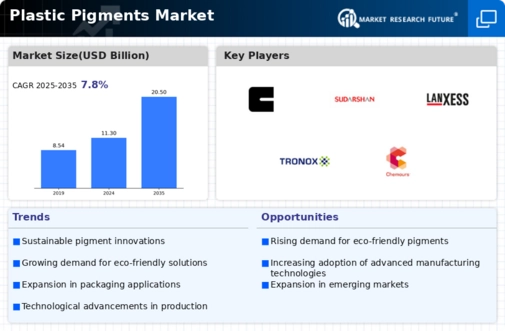Top Industry Leaders in the Plastic Pigments Market
 The world of plastic is far more vibrant than one might imagine, and the magic behind those eye-catching hues lies in the realm of plastic pigments. These colorants, both organic and inorganic, are the unsung heroes behind the aesthetics of countless plastic products, from vibrant packaging to sleek automotive components. But beyond their color-wielding power, the plastic pigments market is a battlefield of fierce competition, with industry giants and niche players clashing for market share. Let's delve into this dynamic market, exploring the strategies, factors impacting dominance, and the latest developments coloring the landscape.
The world of plastic is far more vibrant than one might imagine, and the magic behind those eye-catching hues lies in the realm of plastic pigments. These colorants, both organic and inorganic, are the unsung heroes behind the aesthetics of countless plastic products, from vibrant packaging to sleek automotive components. But beyond their color-wielding power, the plastic pigments market is a battlefield of fierce competition, with industry giants and niche players clashing for market share. Let's delve into this dynamic market, exploring the strategies, factors impacting dominance, and the latest developments coloring the landscape.
Strategies Shaping the Arena:
-
Innovation: The quest for environmentally friendly, lightfast, and heat-resistant pigments is paramount. Companies like Clariant and Sun Chemical are leading the charge with bio-based pigments and sustainable production processes. -
Product Diversification: Offering a comprehensive palette and catering to specific end-use industries – automotive, packaging, construction – expands reach and attracts diversified clientele. BASF and Lanxess excel in this aspect. -
Geographic Expansion: Emerging economies in Asia and Latin America present lucrative opportunities. Companies like DIC Corporation and Tinuvin Chemicals are aggressively expanding their footprint in these regions. -
Mergers and Acquisitions: Consolidating market share through strategic acquisitions is a common tactic. Recent examples include Cabot Corporation acquiring Cequerel and Kronos Worldwide merging with Huntsman Pigments & Additives. -
Vertical Integration: Controlling the supply chain, from raw materials to finished pigments, provides cost advantages and greater control over quality. Companies like Evonik and Merck KGaA are actively pursuing this strategy.
The Keys to Market Share Strongholds:
-
Price Competitiveness: Finding the sweet spot between cost and quality is crucial. Asian manufacturers often hold an edge in price sensitivity. -
Technological Prowess: Investing in R&D for novel pigments and production processes differentiates leaders from followers. Companies like Ferro Corporation and Huber Engineered Materials are known for their innovative prowess. -
Regulatory Compliance: Navigating the complex web of environmental and safety regulations is essential. BASF and Lanxess excel in this domain. -
Brand Reputation: A strong brand reputation built on reliability and quality fosters customer loyalty. Companies like Clariant and Sun Chemical have established themselves as trusted names in the pigment world. -
Distribution Network: A robust distribution network ensures timely delivery and market reach. Companies like Cabot Corporation and DIC Corporation possess extensive distribution channels.
Key Players
- BASF SE (Germany)
- Heubach GmbH (Germany)
- Clariant (Switzerland)
- Sudarshan Chemical Industries Limited (India)
- DIC CORPORATION (Japan)
- Atul Ltd (India)
- Lanxess (Germany)
- Mazda Colours Ltd.(India)
- Tronox Limited (US)
- The Chemours Company. Chemours (US)
Recent Developments:
October 2023: Lanxess unveils a new range of high-performance pigments for automotive applications, catering to the increasing demand for lighter and more durable car parts.
September 2023: Sun Chemical acquires ColorMatrix GmbH, strengthening its foothold in the European market and expanding its portfolio of specialty pigments.
August 2023: Clariant collaborates with a start-up on developing bio-based pigments from wood waste, aiming to revolutionize the sustainability of the plastic pigment industry.
July 2023: The European Union enacts stricter regulations on cadmium-based pigments, prompting manufacturers to shift towards safer alternatives.
June 2023: BASF reports record-breaking sales in its pigments division, driven by strong demand from emerging markets and increased focus on high-performance pigments.









